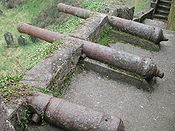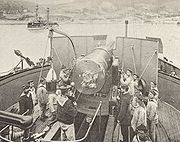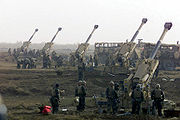
Artillery battery
Encyclopedia

Military organization
Military organization is the structuring of the armed forces of a state so as to offer military capability required by the national defence policy. In some countries paramilitary forces are included in a nation's armed forces...
s, an artillery battery is a unit of guns, mortar
Mortar (weapon)
A mortar is an indirect fire weapon that fires explosive projectiles known as bombs at low velocities, short ranges, and high-arcing ballistic trajectories. It is typically muzzle-loading and has a barrel length less than 15 times its caliber....
s, rocket
Rocket
A rocket is a missile, spacecraft, aircraft or other vehicle which obtains thrust from a rocket engine. In all rockets, the exhaust is formed entirely from propellants carried within the rocket before use. Rocket engines work by action and reaction...
s or missiles so grouped in order to facilitate better battlefield communication
Communication
Communication is the activity of conveying meaningful information. Communication requires a sender, a message, and an intended recipient, although the receiver need not be present or aware of the sender's intent to communicate at the time of communication; thus communication can occur across vast...
and command and control, as well as to provide dispersion for its constituent gunnery crews and their systems. The term is also used in a naval
Naval artillery
Naval artillery, or naval riflery, is artillery mounted on a warship for use in naval warfare. Naval artillery has historically been used to engage either other ships, or targets on land; in the latter role it is currently termed naval gunfire fire support...
context to describe groups of guns on warships.
Land usage
Historically the term 'battery' referred to a group of ordnance systems (commonly cannon) in action, used as field artilleryField artillery
Field artillery is a category of mobile artillery used to support armies in the field. These weapons are specialized for mobility, tactical proficiency, long range, short range and extremely long range target engagement....
or in a siege of a fortress or a city. Such batteries could be a mixture of cannon, howitzer
Howitzer
A howitzer is a type of artillery piece characterized by a relatively short barrel and the use of comparatively small propellant charges to propel projectiles at relatively high trajectories, with a steep angle of descent...
, or mortar types. A siege could involve many batteries. The term also came to be used for a group of cannon in a fixed fortification, for coastal or frontier defence, and for the placement of artillery in a temporary field position during a battle. During the 18th century 'battery' began to be used as an organizational term for a permanent unit of artillery in peace and war, usually organised with between six and twelve ordnance pieces, often including cannon and howitzers. By the late 19th century this use had become normal and mostly replaced earlier terms for artillery units such as company or troop.
In the 20th century the term was generally used for the company level sub-unit of an artillery branch including field, air-defence, anti-tank and position (coast and frontier defences). Artillery operated target acquisition emerged during World War 1 and were also grouped into batteries and have subsequently expanded to include the complete intelligence, surveillance, target acquisition and reconnaissance (ISTAR) spectrum. Twentieth-century firing batteries have been equipped with mortars, guns, howitzers, rockets and missiles.
During the Napoleonic Wars
Napoleonic Wars
The Napoleonic Wars were a series of wars declared against Napoleon's French Empire by opposing coalitions that ran from 1803 to 1815. As a continuation of the wars sparked by the French Revolution of 1789, they revolutionised European armies and played out on an unprecedented scale, mainly due to...
some armies started grouping their batteries into larger administrative and field units. Administratively batteries were usually grouped in battalion
Battalion
A battalion is a military unit of around 300–1,200 soldiers usually consisting of between two and seven companies and typically commanded by either a Lieutenant Colonel or a Colonel...
s or squadrons, which were further grouped into regiment
Regiment
A regiment is a major tactical military unit, composed of variable numbers of batteries, squadrons or battalions, commanded by a colonel or lieutenant colonel...
s, simply 'group' or brigade
Brigade
A brigade is a major tactical military formation that is typically composed of two to five battalions, plus supporting elements depending on the era and nationality of a given army and could be perceived as an enlarged/reinforced regiment...
s, that may be wholly composed of artillery units or combined arms
Combined arms
Combined arms is an approach to warfare which seeks to integrate different branches of a military to achieve mutually complementary effects...
in composition.
Groups of batteries combined for field combat employment became known as the Grand Batteries
Grand Battery
Grand Battery was a French artillery tactic of the Napoleonic wars. It involved massing all available batteries into a single large, temporary one, and concentrating the firepower of their guns at a single point in the enemy's lines.Substituting volume of fire for accuracy, rate of fire and rapid...
. To further concentrate fire of individual batteries, from World War I they were grouped into 'artillery divisions'. Coastal artillery
Coastal artillery
Coastal artillery is the branch of armed forces concerned with operating anti-ship artillery or fixed gun batteries in coastal fortifications....
sometimes had completely different organizational terms based on shore defence sector areas.
Batteries also have sub-divisions which vary across armies and periods, but often translate into the English 'platoon' or 'troop' with individual ordnance systems called a 'section', or 'sub-section' where a section comprises two artillery pieces.

The number of guns, howitzers, mortars or launchers in an organizational battery has also varied, with the calibre of guns usually being an important consideration. In the 19th century 4 to 12 pieces guns was usual as the optimum number to maneuver into the gun line. By late 19th century the mountain artillery battery was divided into a gun line and an ammunition line. The gun line consisted of six guns (five mule
Mule
A mule is the offspring of a male donkey and a female horse. Horses and donkeys are different species, with different numbers of chromosomes. Of the two F1 hybrids between these two species, a mule is easier to obtain than a hinny...
s to a gun) and 12 ammunition mules.
During the American Civil War
American Civil War
The American Civil War was a civil war fought in the United States of America. In response to the election of Abraham Lincoln as President of the United States, 11 southern slave states declared their secession from the United States and formed the Confederate States of America ; the other 25...
, artillery batteries often consisted of six field pieces for the Union Army
Union Army
The Union Army was the land force that fought for the Union during the American Civil War. It was also known as the Federal Army, the U.S. Army, the Northern Army and the National Army...
and four for the Confederate States Army
Confederate States Army
The Confederate States Army was the army of the Confederate States of America while the Confederacy existed during the American Civil War. On February 8, 1861, delegates from the seven Deep South states which had already declared their secession from the United States of America adopted the...
, although this varied. Batteries were divided into sections of two guns apiece, each section normally under the command of a lieutenant. The full battery was typically commanded by a captain. Often, particularly as the war progressed, individual batteries were grouped into battalions under a major or colonel
Colonel
Colonel , abbreviated Col or COL, is a military rank of a senior commissioned officer. It or a corresponding rank exists in most armies and in many air forces; the naval equivalent rank is generally "Captain". It is also used in some police forces and other paramilitary rank structures...
of artillery. See Field Artillery in the American Civil War
Field Artillery in the American Civil War
Field artillery in the American Civil War refers to the important artillery weapons, equipment, and practices used by the Artillery branch to support the infantry and cavalry forces in the field. It does not include siege artillery, use of artillery in fixed fortifications, or coastal or naval...
.
In the 20th century it varied between four and twelve for field artillery (even 16 if mortars), or even two pieces for very heavy pieces. Other types of artillery such as anti-tank or anti-aircraft have sometimes been larger. Some batteries have been 'dual-equipped' with two different types of gun or mortar, and taking whichever was most appropriate when they deployed for operations.
Naval usage

Ship of the line
A ship of the line was a type of naval warship constructed from the 17th through the mid-19th century to take part in the naval tactic known as the line of battle, in which two columns of opposing warships would manoeuvre to bring the greatest weight of broadside guns to bear...
, mounted dozens of cannons, carronade
Carronade
The carronade was a short smoothbore, cast iron cannon, developed for the Royal Navy by the Carron Company, an ironworks in Falkirk, Scotland, UK. It was used from the 1770s to the 1850s. Its main function was to serve as a powerful, short-range anti-ship and anti-crew weapon...
s, and other guns in broadsides, sometimes on several decks. This remained the standard layout for centuries, until new designs, such as the revolving turret, made it obsolete.
One of the first rotating turrets
Gun turret
A gun turret is a weapon mount that protects the crew or mechanism of a projectile-firing weapon and at the same time lets the weapon be aimed and fired in many directions.The turret is also a rotating weapon platform...
was designed by John Ericsson
John Ericsson
John Ericsson was a Swedish-American inventor and mechanical engineer, as was his brother Nils Ericson. He was born at Långbanshyttan in Värmland, Sweden, but primarily came to be active in England and the United States...
, for use on the American ironclad
Ironclad warship
An ironclad was a steam-propelled warship in the early part of the second half of the 19th century, protected by iron or steel armor plates. The ironclad was developed as a result of the vulnerability of wooden warships to explosive or incendiary shells. The first ironclad battleship, La Gloire,...
USS Monitor
USS Monitor
USS Monitor was the first ironclad warship commissioned by the United States Navy during the American Civil War. She is most famous for her participation in the Battle of Hampton Roads on March 9, 1862, the first-ever battle fought between two ironclads...
. Other designs used open barbette
Barbette
A barbette is a protective circular armour feature around a cannon or heavy artillery gun. The name comes from the French phrase en barbette referring to the practice of firing a field gun over a parapet rather than through an opening . The former gives better angles of fire but less protection...
s to house their main batteries on rotating mounts. Both designs allowed naval engineers to dramatically reduce the number of guns present in the battery, by giving a handful of guns the ability to concentrate on either side of the ship.
A revolution in ship armament occurred in 1906, with the completion of HMS Dreadnought
HMS Dreadnought (1906)
HMS Dreadnought was a battleship of the British Royal Navy that revolutionised naval power. Her entry into service in 1906 represented such a marked advance in naval technology that her name came to be associated with an entire generation of battleships, the "dreadnoughts", as well as the class of...
. In previous battleship designs, the primary battery often consisted of four large caliber guns in two turrets, one in the front of the ship, and one aft. The ships also had a mixed secondary battery of smaller guns, but were also intended to be used offensively. The differences in gun calibers and ranges made it difficult to accurately judge shell splashes, and thus to fire the guns accurately, which led to decreased effectiveness of the ships. Dreadnought's design did away with the offensive secondary battery, and replaced it with ten heavy caliber guns, and a smaller secondary battery to be used for self defense. This leap in armament made all other battleships obsolete.

German battleship Bismarck
Bismarck was the first of two s built for the German Kriegsmarine during World War II. Named after Chancellor Otto von Bismarck, the primary force behind the German unification in 1871, the ship was laid down at the Blohm & Voss shipyard in Hamburg in July 1936 and launched nearly three years later...
, which carried a primary battery of eight 15 inch (380mm) guns, along with a secondary battery of twelve 5.9 inch (150mm) guns for defense against destroyers and torpedo boats, as well as a tertiary battery of various anti-aircraft guns ranging in caliber from 4.1 inch (105mm) to 20mm guns. Many later ships used dual-purpose guns
Dual purpose gun
A dual purpose gun is a naval artillery mounting designed to engage both surface and air targets.-Description:Second World War-era capital ships had four classes of artillery: the heavy main battery, intended to engage opposing battleships and cruisers ; a secondary battery for use against enemy...
to combine the secondary battery and the heavier guns of the tertiary batteries, in order to simplify the design.
Most modern vessels have largely done away with conventional artillery, instead using cruise and guided missiles for most offensive and defensive purposes, respectively. Guns are retained for niche roles, such as the Phalanx CIWS
Phalanx CIWS
The Phalanx CIWS is an anti-ship missile defense system. It is a close-in weapon system and was designed and manufactured by the General Dynamics Corporation, Pomona Division...
, a multi-barrel rotary cannon used for point defense
Point-defence
Point-defence is the defence of a single object or a limited area, e.g. a ship, building or an airfield, now usually against air attacks and guided missiles...
, or the Mark 45 5 inch, which is used for close defense against surface combatants and shore bombardment.
Modern battery organization

Howitzer
A howitzer is a type of artillery piece characterized by a relatively short barrel and the use of comparatively small propellant charges to propel projectiles at relatively high trajectories, with a steep angle of descent...
s or 6 to 9 rocket launchers and 100 to 200 personnel. In the U.S. Army, generally a towed howitzer battery has 6 guns, where a self-propelled battery (such as an M 109
M109 howitzer
The M109 is an American-made self-propelled 155 mm howitzer, first introduced in the early 1960s. It was upgraded a number of times to today's M109A6 Paladin...
battery) contains 8. They are subdivided into:
- Field batteries, equipped with 105 mm howitzers or equivalent;
- Medium batteries, equipped with 155 mm howitzers or equivalent;
- Heavy batteries, which are equipped with guns of 203 mm or more calibre, but are now very rare; and
- Various more specialised types, such as anti-aircraft, missileMissileThough a missile may be any thrown or launched object, it colloquially almost always refers to a self-propelled guided weapon system.-Etymology:The word missile comes from the Latin verb mittere, meaning "to send"...
, or Multiple Launch Rocket System batteries. - Headquarters batteries, which themselves have no artillery pieces, but are rather the command and control organization for a group of firing batteries (for example, a regimental or battalion headquarters battery).
The battery is typically commanded by a captain in U.S. forces and is equivalent to an infantry
Infantry
Infantrymen are soldiers who are specifically trained for the role of fighting on foot to engage the enemy face to face and have historically borne the brunt of the casualties of combat in wars. As the oldest branch of combat arms, they are the backbone of armies...
company
Company (military unit)
A company is a military unit, typically consisting of 80–225 soldiers and usually commanded by a Captain, Major or Commandant. Most companies are formed of three to five platoons although the exact number may vary by country, unit type, and structure...
. In United Kingdom and Commonwealth
Commonwealth of Nations
The Commonwealth of Nations, normally referred to as the Commonwealth and formerly known as the British Commonwealth, is an intergovernmental organisation of fifty-four independent member states...
forces a battery commander, or "BC" is a Major (like his infantry company commander counterpart). However, in these armies the battery commander leads the 'tactical group' and is usually located with the headquarters of the infantry or amoured unit the battery is supporting. The battery position is commanded by the BC's second-in-command, the Battery Captain (BK). Increasingly these direct support battery commanders are responsible for the orchestration of all forms of fire support (mortars, attack helicopters, other aircraft and naval gunfire) as well as artillery. General support battery commanders are likely to be at brigade or higher headquarters.
A US battery is divided into the following units:
- The firing sectionSection (military unit)A section is a small military unit in some armies. In many armies, it is a squad of seven to twelve soldiers. However in France and armies based on the French model, it is the sub-division of a company .-Australian Army:...
, which includes the individual gun sections. Each gun section is typically led by a staff sergeant (US Army Enlisted pay grade E-6); the firing section as a whole is usually led by a lieutenant and a senior NCO.
- The fire direction center (FDC), which computes firing solutions based on map coordinates, receives fire requests and feedback from observers and infantry units, and communicates directions to the firing section. It also receives commands from higher headquarters (i.e. the battalion FDC sends commands to the FDCs of all three of its batteries for the purpose of synchronizing a barrage).
Other armies can be significantly different, however. For example: the basic field organization being the 'gun group' and the 'tactical group'. The former being reconnaissance and survey, guns, command posts, logistic and equipment support elements, the latter being the battery commander and observation teams that deploy with the supported arm. In these armies the guns may be split into several fire units, which may deploy dispersed over an extended area or be concentrated into a single position. It some cases batteries have operationally deployed as 6 totally separate guns, although sections (pairs) are more usual.
During the Cold War NATO batteries that were dedicated to a nuclear role generally operated as 'sections' comprising a single gun or launcher.
Groupings of mortars, when they are not operated by artillery, are usually referred to as platoon
Platoon
A platoon is a military unit typically composed of two to four sections or squads and containing 16 to 50 soldiers. Platoons are organized into a company, which typically consists of three, four or five platoons. A platoon is typically the smallest military unit led by a commissioned officer—the...
s.

